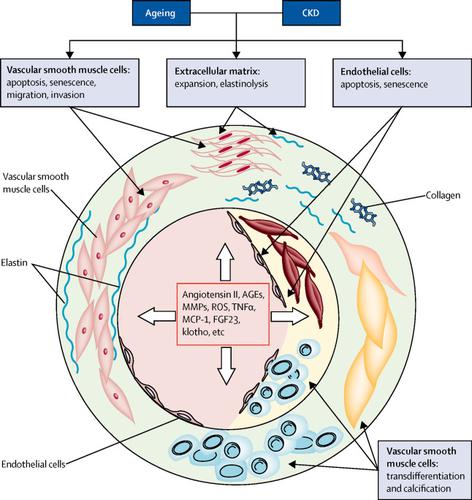Our official English website, www.x-mol.net, welcomes your
feedback! (Note: you will need to create a separate account there.)
Bone and mineral disorders in chronic kidney disease: implications for cardiovascular health and ageing in the general population.
The Lancet ( IF 98.4 ) Pub Date : 2018-04-01 , DOI: 10.1016/s2213-8587(17)30310-8 Adrian Covic , Marc Vervloet , Ziad A Massy , Pablo Ureña Torres , David Goldsmith , Vincent Brandenburg , Sandro Mazzaferro , Pieter Evenepoel , Jordi Bover , Mugurel Apetrii , Mario Cozzolino
The Lancet ( IF 98.4 ) Pub Date : 2018-04-01 , DOI: 10.1016/s2213-8587(17)30310-8 Adrian Covic , Marc Vervloet , Ziad A Massy , Pablo Ureña Torres , David Goldsmith , Vincent Brandenburg , Sandro Mazzaferro , Pieter Evenepoel , Jordi Bover , Mugurel Apetrii , Mario Cozzolino

|
The patient with chronic kidney disease (CKD) represents an extreme model for arteriosclerosis, vascular calcification, and bone disorders, all of which are also associated with ageing in the general population. These pathological features are also relevant to other common chronic health disorders such as diabetes, and chronic inflammatory and cardiovascular diseases. Although management and interventions for these major risk factors are now incorporated into most public health guidelines (eg, smoking cessation and control of bodyweight and blood pressure, as well as glucose and cholesterol concentrations), some residual cardiovascular risk is not reduced by implementation of these interventions. CKD should be regarded as an atypical disease in which both traditional and novel cardiovascular risk factors have effects on outcomes. But CKD can also be viewed conceptually as an accelerator of traditional cardiovascular risk factors. Findings from research into mineral bone disorder associated with CKD (CKD-MBD) could help the medical community to better understand the vascular actions of certain molecules, such as phosphates, fibroblast growth factor 23, parathyroid hormone, sclerostin, or vitamin D and their relevance to the management of different pathologies in the general population. Importantly, these components, which are recognised in nephrology, could help to explain residual risk of cardiovascular events in the general population. Thus, achieving a better understanding of CKD-MBDs could provide substantial insight into future treatments for arteriosclerosis and osteoporosis, which are strongly associated with ageing and morbidity in the general population.
中文翻译:

慢性肾脏疾病的骨骼和矿物质疾病:对普通人群心血管健康和衰老的影响。
患有慢性肾脏疾病(CKD)的患者代表了动脉硬化,血管钙化和骨骼疾病的极端模型,所有这些因素均与普通人群的衰老有关。这些病理特征也与其他常见的慢性健康疾病有关,例如糖尿病,慢性炎症和心血管疾病。尽管现在已将这些主要危险因素的管理和干预措施纳入了大多数公共卫生指南(例如,戒烟和控制体重,血压以及葡萄糖和胆固醇浓度),但通过实施这些措施并不能降低一些残余的心血管风险干预。CKD应被视为非典型疾病,传统和新型心血管危险因素均会影响预后。但是从概念上讲,CKD也可以看作是传统心血管危险因素的加速器。对与CKD相关的矿物质骨疾病(CKD-MBD)的研究发现可以帮助医学界更好地了解某些分子的血管作用,例如磷酸盐,成纤维细胞生长因子23,甲状旁腺激素,硬化素或维生素D及其相关性应对普通人群中不同病理的管理。重要的是,这些成分在肾脏病学中得到公认,可以帮助解释普通人群中心血管事件的残留风险。因此,更好地了解CKD-MBDs可以为深入了解动脉硬化和骨质疏松症的未来治疗提供实质性信息,这与普通人群的衰老和发病率密切相关。
更新日期:2018-03-21
中文翻译:

慢性肾脏疾病的骨骼和矿物质疾病:对普通人群心血管健康和衰老的影响。
患有慢性肾脏疾病(CKD)的患者代表了动脉硬化,血管钙化和骨骼疾病的极端模型,所有这些因素均与普通人群的衰老有关。这些病理特征也与其他常见的慢性健康疾病有关,例如糖尿病,慢性炎症和心血管疾病。尽管现在已将这些主要危险因素的管理和干预措施纳入了大多数公共卫生指南(例如,戒烟和控制体重,血压以及葡萄糖和胆固醇浓度),但通过实施这些措施并不能降低一些残余的心血管风险干预。CKD应被视为非典型疾病,传统和新型心血管危险因素均会影响预后。但是从概念上讲,CKD也可以看作是传统心血管危险因素的加速器。对与CKD相关的矿物质骨疾病(CKD-MBD)的研究发现可以帮助医学界更好地了解某些分子的血管作用,例如磷酸盐,成纤维细胞生长因子23,甲状旁腺激素,硬化素或维生素D及其相关性应对普通人群中不同病理的管理。重要的是,这些成分在肾脏病学中得到公认,可以帮助解释普通人群中心血管事件的残留风险。因此,更好地了解CKD-MBDs可以为深入了解动脉硬化和骨质疏松症的未来治疗提供实质性信息,这与普通人群的衰老和发病率密切相关。











































 京公网安备 11010802027423号
京公网安备 11010802027423号